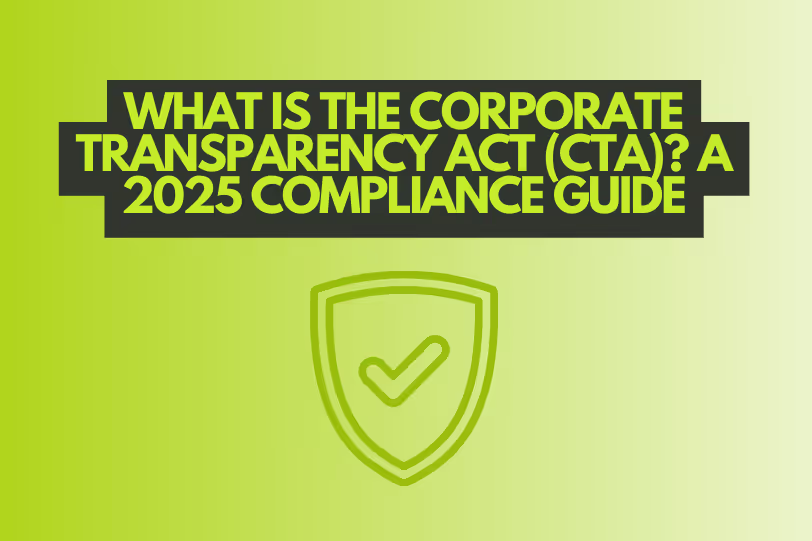
What Is CTA (Corporate Transparency Act)? A 2025 Compliance Guide
Learn what the Corporate Transparency Act (CTA) is, why beneficial ownership reporting matters, and how it impacts anti-money laundering compliance programs.
As of January 2024, the United States implemented the Corporate Transparency Act (CTA) to close long-standing gaps in financial transparency and prevent illicit actors from using anonymous companies to conceal criminal activity.
The CTA represents one of the most significant regulatory shifts in recent years, particularly for anti-money laundering compliance and financial crime prevention. Businesses must understand the law’s requirements around beneficial ownership reporting, enforcement deadlines, and its implications for compliance teams worldwide.
What Is the Corporate Transparency Act?
The Corporate Transparency Act (CTA) is a U.S. law requiring most companies formed or registered to do business in the United States to report information about their beneficial owners to the Financial Crimes Enforcement Network (FinCEN). Beneficial owners are individuals who ultimately own or control at least 25% of the company or exercise substantial control over it.
By mandating beneficial ownership disclosure, the CTA aims to make it harder for criminals, corrupt officials, and terrorists to exploit anonymous shell companies for money laundering, tax evasion, or sanctions evasion. The data collected will not be public but will be available to law enforcement, regulators, and financial institutions conducting due diligence.
Why Was the CTA Introduced?
For decades, the U.S. was criticized as a haven for anonymous companies because it allowed businesses to form entities without disclosing their true owners. This lack of transparency made it easier for criminals to launder money through shell structures while avoiding detection.
The CTA brings the U.S. in line with global standards set by the Financial Action Task Force (FATF), which emphasizes beneficial ownership reporting as a cornerstone of effective financial crime prevention. By increasing transparency, the law strengthens U.S. efforts against money laundering, corruption, and terrorist financing.
Who Must Comply with the CTA?
The CTA applies broadly to “reporting companies,” which include both domestic and foreign entities registered to do business in the United States. These are typically corporations, limited liability companies (LLCs), and other entities created by filing with a secretary of state.
However, there are 23 exemptions, including publicly traded companies, banks, credit unions, insurance firms, and certain large operating companies that meet employee, revenue, and physical presence requirements. These exemptions aim to reduce unnecessary reporting burdens while ensuring high-risk entities remain within the CTA’s scope.
What Information Must Be Reported?
Reporting companies must file details on both the entity and its beneficial owners. The required information includes:
- For the company: legal name, trade names, business address, jurisdiction of formation, and tax identification number.
- For beneficial owners: full legal name, date of birth, residential address, and an identifying document such as a passport or driver’s license.
This information must be submitted to FinCEN through the Beneficial Ownership Secure System (BOSS), a non-public database designed to protect sensitive data while ensuring access for authorized parties.
Deadlines and Enforcement
The CTA’s reporting deadlines depend on when the company was formed:
- Companies created before January 1, 2024 must file initial reports by January 1, 2025.
- Companies created on or after January 1, 2024, and before January 1, 2025 have 90 days from registration to file.
- Companies created on or after January 1, 2025 will have 30 days to submit their initial report.
Failure to comply can result in civil penalties of up to $500 per day and criminal penalties, including fines up to $10,000 and imprisonment of up to two years for willful violations. These enforcement measures underscore the importance of timely and accurate reporting. (See: Understanding AML Fines).
How the CTA Impacts Anti-Money Laundering Compliance
For compliance professionals, the CTA represents a significant shift in how anti-money laundering compliance is managed in the U.S. Financial institutions conducting due diligence will have access to verified beneficial ownership data through FinCEN, improving the accuracy of customer risk assessments.
This also reduces reliance on self-reported ownership information from customers, which has historically been prone to gaps or manipulation. By strengthening data integrity, the CTA enhances institutions’ ability to detect and prevent financial crime.
CTA and Beneficial Ownership Reporting Globally
The CTA aligns the U.S. with international best practices. Many jurisdictions, including the European Union, already require beneficial ownership registries under AML directives.
While the U.S. system differs in that its database is not publicly accessible, the shift signals a stronger commitment to financial crime prevention and greater cooperation with global regulators. This harmonization will support multinational compliance programs that span both U.S. and international entities.
Compliance Challenges for Businesses
Despite its benefits, the CTA creates challenges for businesses—particularly small companies unfamiliar with regulatory reporting. Many will need support in identifying beneficial owners, maintaining accurate records, and filing within deadlines.
Larger organizations must ensure that their compliance frameworks incorporate CTA reporting alongside other obligations, such as CDD vs EDD (Customer Due Diligence vs Enhanced Due Diligence) requirements. Integrating CTA processes into existing workflows is key to avoiding duplication and ensuring efficiency.
Best Practices for CTA Compliance
Businesses can prepare for the CTA by adopting several best practices:
- Map Ownership Structures: Identify beneficial owners early and update records as changes occur.
- Centralize Data Management: Store ownership details in secure systems that can feed into FinCEN filings.
- Train Staff: Educate compliance and legal teams on CTA requirements and reporting obligations.
- Leverage Technology: Use compliance platforms to automate beneficial ownership identification and reporting.
These measures will help organizations remain compliant while reducing the risk of penalties and reputational harm.
Technology’s Role in Meeting CTA Obligations
Technology can simplify beneficial ownership reporting by automating data collection, managing ownership hierarchies, and integrating filings with regulatory systems.
AI-driven tools also support financial crime prevention by cross-referencing beneficial owners against global sanctions and watchlists, including the OFAC sanctions list. This ensures compliance teams are not only meeting CTA requirements but also strengthening their broader AML programs.
The Future of Corporate Transparency
The CTA represents just the beginning of a new era in corporate transparency. As regulators worldwide push for greater accountability, businesses should expect expanding requirements around ownership disclosure, data sharing, and risk assessments.
For compliance teams, the message is clear: treat the CTA as part of a larger movement toward global transparency and anti-money laundering compliance, not just a standalone U.S. requirement. Proactive investment in systems and processes today will help future-proof compliance frameworks.
{{snippets-guide}}
Conclusion
The CTA is a groundbreaking U.S. law requiring companies to disclose beneficial ownership information to FinCEN, aimed at preventing money laundering, corruption, and financial crime.
For businesses, the CTA introduces new compliance obligations but also provides opportunities to strengthen due diligence and risk management. By embracing beneficial ownership reporting, adopting technology, and aligning with global AML standards, companies can stay ahead of regulatory expectations and contribute to stronger financial crime prevention efforts worldwide.
sanctions.io is a highly reliable and cost-effective solution for real-time screening. AI-powered and with an enterprise-grade API with 99.99% uptime are reasons why customers globally trust us with their compliance efforts and sanctions screening needs.
To learn more about how our sanctions, PEP, and criminal watchlist screening service can support your organization's compliance program: Book a free Discovery Call.
We also encourage you to take advantage of our free 7-day trial to get started with your sanctions and AML screening (no credit card is required).



